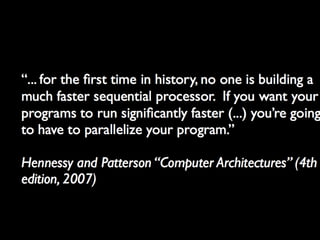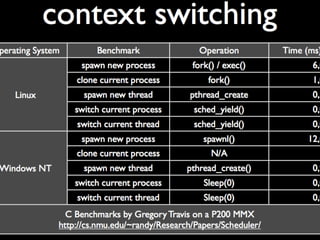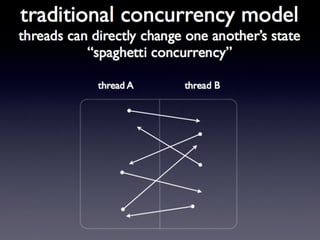Concurrent programming1
- 1. Highly Concurrent Programming Nick Brandaleone Lecture 1
- 3. The End of Moore’s Law
- 4. The End of Moore’s Law Why we don’t have 10 GHz chips today Chips are too big Signals can no longer reach the whole chip in a clock cycle Problems with heat dissipation
- 5. The Multicore Era Manufactures have turned towards multi-core processors in order to increase speed They are capable of doing multiple calculations in parallel CPU speeds are likely to stay relatively flat
- 7. The Concurrency Revolution Intel HyperThreading - hardware supported Future computer architectures will have greater number of cores, from the desktop (12 typical for workstation) to the smartphone (2 in iPhone) You will need to develop well-written concurrent applications to gain from this hardware development
- 8. Vocabulary Parallelism Programming as the simultaneous execution of (possibly related) computations Concurrency Programming as the composition of independently executing processes
- 12. Shared State Concurrency Threads concurrently execute code Contains resources that must be shared Synchronization is required via locks Data consistency Visibility Correct ordering
- 14. Why locking is evil “non-trivial multi-threaded programs are incomprehensible to human …” - Edward A. Lee, The Problem with Threads “humans are quickly overwhelmed by concurrency and find it much more difficult to reason about concurrent than sequential code” - Sutter and Larus “I have a firm belief that locking primitives are evil”
- 16. Message Passing Carl Hewitt, Richard Steiger and Peter Bishop released a paper in 1973 introducing the Actor Model concept C.A.R. Hoare: Communicating Sequential Processes (CSP). Introduced in 1978. Very similar concepts. We shall refer to them both as “message passing” (aka process calculus)
- 20. Alternative Models Language Method Erlang Actors Go Concurrent Sequential Processing Clojure Software Transactional Memory Icon Coexpressions
- 21. Key Concepts Actors (or go routines) instead of objects No shared state between actors Asynchronous message-passing Share memory by communicating
- 22. Amdahl’s Law
- 23. Goals for this course: Learn Concurrent Programming using CSP/Actor model Become familiar with concurrent programming idioms All assignments can be fulfilled using Language of choice •Elixir (Erlang) •Go (the new “C”) •Scala (Java) •Haskell (purely functional) Grade •Weekly HW •Mid-term quiz •Final Project
- 24. The Languages
- 25. Erlang A functional, dynamically typed language Invented at Ericsson in 1986 Designed for concurrency, scalability and reliability
- 26. Erlang in the real world Ericsson ATM switch (301 model) 99.9999999 percent uptime Facebook chat 100s of millions concurrent users RabbitMQ High performance AMQP Apache CouchDB distributed, fault-tolerant document DB
- 29. Syntactic Sugar for Erlang
- 30. Elixir example
- 31. Go Language Developed by Rob Pike, formerly of Bell Labs Statically compiled and typed language, loosely based upon C syntax Supports Garbage Collection, and Concurrency Used internally at Google Strong community support and documentation
- 32. Go example
- 33. Scala The new “Java”. Runs on Java VM Object oriented and functional design Very flexible Can use Java libraries Syntax can be tough due to mix of OO and F
- 34. Scala example
- 35. Haskell Purely functional programming language Built-in support for concurrency and parallelism Typically used more in research community than commercially Powerful but confusing syntax
- 36. Haskell example
- 37. FUNCTIONAL VS IMPERATIVE OR OO PROGRAMMING STYLES
- 38. Homework Research language that you would like to use Watch http://blog.golang.org/concurrency-is-not- parallelism video by Rob Pike Work on Assignment #1 for next week






































